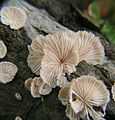Schizophyllum commune
| Schizophyllum commune | |
|---|---|
.jpg) | |
| Scientific classification | |
| Kingdom: | Fungi |
| Division: | Basidiomycota |
| Class: | Basidiomycetes |
| Order: | Agaricales |
| Family: | Schizophyllaceae |
| Genus: | Schizophyllum |
| Species: | S. commune |
| Binomial name | |
| Schizophyllum commune Fries | |
| Synonyms | |
|
Agaricus alneus L., (1755) | |
Schizophyllum commune is a very common species of mushroom in the genus Schizophyllum. It is the world's most widely distributed mushroom, occurring on every continent except Antarctica.[1]
Although European and US guidebooks list it as inedible, this is apparently due to differing standards of taste rather than known toxicity, being regarded with little culinary interest due to its tough texture. S. commune is, in fact, edible and widely consumed in Mexico and elsewhere in the tropics.[2] And in North-East India, the state Manipur called it as "Kanglayen" and its one of the favourite ingredients for Manipuri-Pancake Style called Paaknam. The authors explain the preference for tough, rubbery mushrooms in the tropics as a consequence of the fact that tender, fleshy mushrooms quickly rot in the hot humid conditions there, making their marketing problematic.
The gills, which produce basidiospores on their surface split when the mushroom dries out, earning this mushroom the common name Split Gill. It has more than 28,000 sexes.[1]
It is common in rotting wood, but can also cause disease in humans.[3]
Hydrophobin was first isolated from Schizophyllum commune.
Description
The cap is shell-shaped, with the tissue concentrated at the point of attachment, resembling a stem. It is often wavy and lobed, with a rigid margin when old. It is tough, felty and hairy, and slippery when moist. It is greyish white and up to 4 cm in diameter. The gills are pale reddish or grey, very narrow with a longitudinal split edge which becomes inrolled when wet; the only knows fungus with spit gills that are capable of retracting by movement. It is found predominantly from autumn to spring on dead wood, in coniferous and deciduous forest.
Genetics
The genome of Schizophyllum commune was sequenced in 2010.[4]
-

Schizophyllum commune Elk Grove, IL
-

References
| Schizophyllum commune | |
|---|---|
|
| |
| pores on hymenium | |
|
cap is offset or indistinct | |
| hymenium is decurrent | |
| lacks a stipe | |
| spore print is white | |
| ecology is saprotrophic | |
| edibility: inedible | |
- ↑ 1.0 1.1 "Tom Volk's Fungus of the Month for February 2000"
- ↑ Ruán-Soto et al. (2006), "Process and dynamics of traditional selling of wild edible mushrooms in tropical Mexico" (Free full text), Ethnobiology and Ethnomedicine 2 (3)
- ↑ Guarro, J; Genéj; Stchigel, Am (Jul 1999), "Developments in Fungal Taxonomy" (Free full text), Clinical Microbiology Reviews 12 (3): 454–500, ISSN 0893-8512, PMC 100249, PMID 10398676
- ↑ Robin A Ohm,; De Jong, JF; Lugones, LG; Aerts, A; Kothe, E; Stajich, JE; De Vries, RP; Record, E et al. (Jul 2010), "Genome sequence of the model mushroom Schizophyllum commune", Nature Biotechnology 28 (9): 957–63, doi:10.1038/nbt.1643, PMID 20622885
External links
- "Schizophyllum commune", MykoWeb
| Wikimedia Commons has media related to Schizophyllum commune. |
| External identifiers for Schizophyllum commune | |
|---|---|
| Encyclopedia of Life | 1017353 |
| Also found in: Wikispecies | |